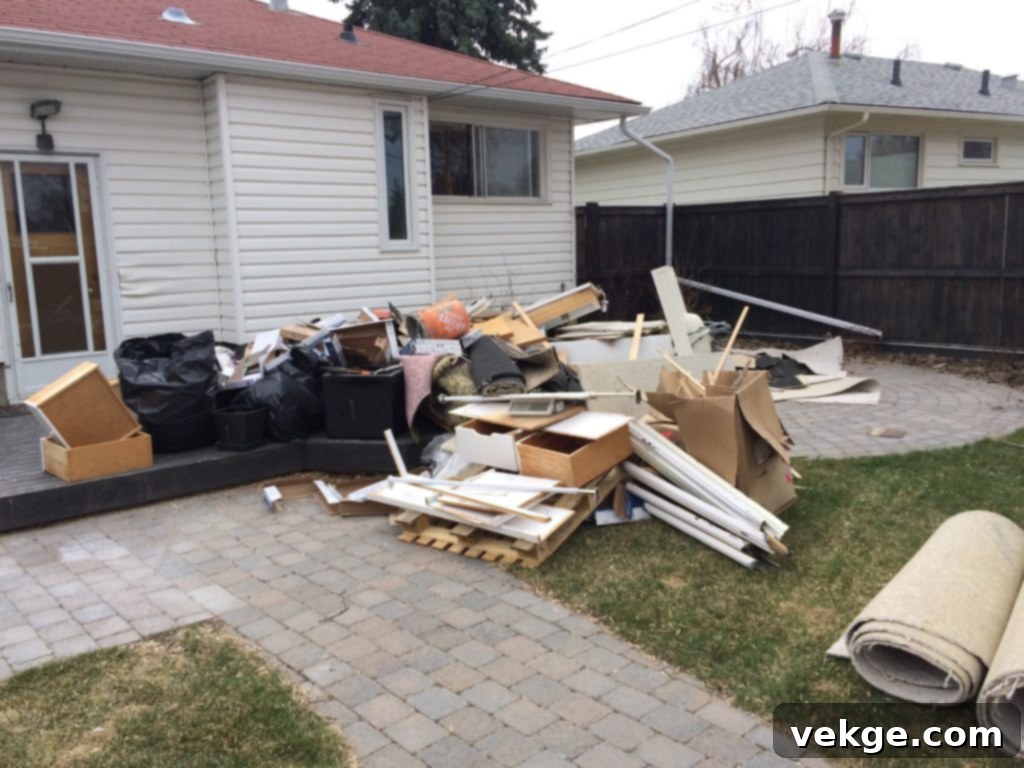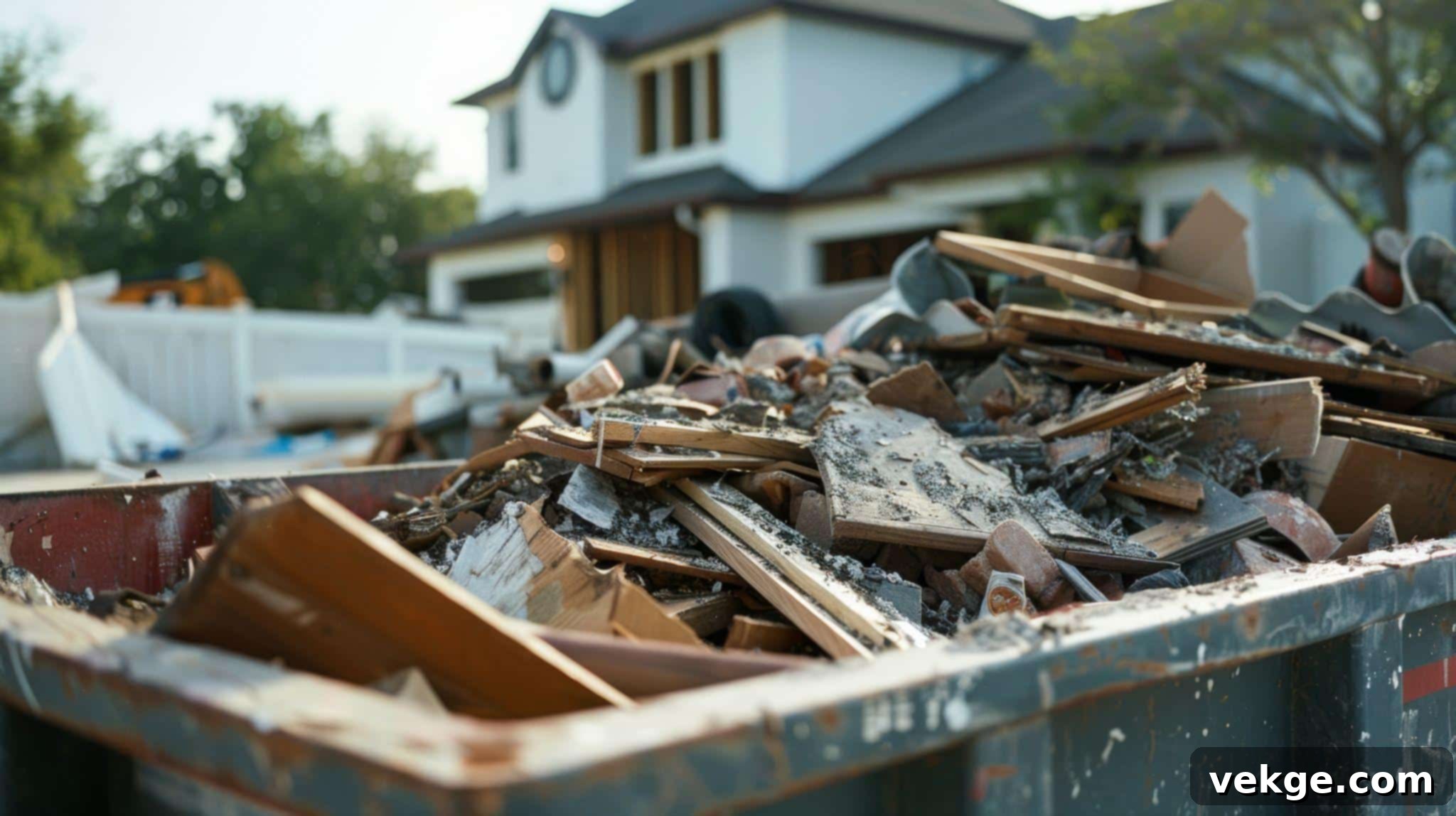Sustainable Home Renovations: An Essential Guide to Eco-Friendly Waste Management
Embarking on a home renovation project is an exciting endeavor, promising to transform your living space and enhance its functionality and aesthetic appeal. However, beneath the excitement lies a significant challenge: waste management. Home renovations inevitably generate a substantial amount of waste, ranging from old furniture, appliances, and fixtures to significant quantities of construction and demolition debris. Effectively managing this waste isn’t just about keeping your site tidy; it’s a critical aspect of environmental responsibility, crucial for minimizing your ecological footprint and ensuring your peace of mind throughout the renovation process.
This comprehensive guide offers a simple, yet detailed, approach to sustainably managing waste during your home renovations. By adopting these strategies, you can significantly reduce landfill contributions, promote recycling and reuse, and make your renovation project as green as possible.
Plan Ahead for a Greener Renovation

The foundation of any successful eco-friendly renovation lies in meticulous planning. Proactive waste management can save you time, money, and reduce environmental impact.
1. Thoroughly Assess Your Renovation Project
Before any demolition begins or new materials are ordered, dedicate time to comprehensively assess the scope and scale of your renovation. This involves more than just design choices; it’s about understanding the material flow. Identify every type of material you intend to remove—from old drywall and flooring to cabinetry and plumbing fixtures. Simultaneously, list the new materials that will be introduced. This detailed inventory will provide a clear picture of the potential waste streams you’ll generate, allowing you to anticipate volumes and plan appropriate disposal and recycling strategies.
2. Develop a Comprehensive Waste Management Plan
Once you’ve assessed your project, create a detailed waste management plan. This document should outline specific strategies for each type of material. Your plan should prioritize the “3 R’s” of waste management: Reduce, Reuse, and Recycle, before considering responsible disposal. Assign responsibilities if multiple people are involved, and allocate a budget for waste disposal services, as this can be a significant cost. Consider including a timeline for waste removal to keep your project on schedule and your site clear.
Minimize Waste Generation: The First Step to Sustainability
Reducing waste at its source is the most effective strategy for an eco-friendly renovation. Every item you don’t purchase or can repurpose is one less item destined for a landfill.
1. Meticulous Planning and Precise Measuring
One of the simplest yet most impactful ways to reduce renovation waste is through careful planning and accurate material measurement. Before purchasing any supplies, double-check all dimensions and calculate material needs precisely. Avoid the temptation to “over-order” just in case; instead, aim for exact quantities, factoring in a small contingency for cuts and mistakes. Buying in bulk should only be considered if you are certain you will use all of the material, or if there’s a clear plan for the excess. This precision minimizes off-cuts and leftover materials, directly translating to less waste and often, cost savings.
2. Embrace Reuse and Creative Repurposing of Materials
Before automatically discarding old materials, pause and consider their potential for reuse or repurposing. Many items, though outdated for your current design, may still be perfectly functional or suitable for a new life. Old kitchen cabinets can be repainted and installed in a garage or basement workshop, or even disassembled for their wood. Doors, windows, light fixtures, and plumbing components can often be restored, upcycled, or used in different areas of your home. For items you can’t use, explore platforms like Freecycle, Craigslist, Facebook Marketplace, or local online community groups. These are excellent resources for giving away items in good condition to others who can benefit from them, preventing them from ending up in landfills and fostering a circular economy.
Recycle and Divert: Giving Materials a Second Chance

After reducing and reusing, recycling is the next critical step in sustainable waste management. Many common renovation materials can be recycled, significantly reducing the volume of waste sent to landfills.
1. Identify and Segregate Recyclable Materials
During the demolition and clean-up phases, make a conscious effort to identify and separate recyclable materials from general waste. Common construction and demolition (C&D) waste items that are often recyclable include metals (copper pipes, aluminum, steel), clean wood (untreated lumber, plywood), concrete, asphalt, bricks, cardboard, and certain types of plastics. Set up clearly labeled bins or designated areas on your renovation site for different material types. This segregation is crucial because commingled waste is much harder and more expensive to recycle, and sometimes impossible. By keeping materials separate, you ensure they can be processed efficiently by recycling facilities.
2. Utilize Local Recycling Centers and Specialized Facilities
Research your local recycling infrastructure. Many municipal recycling centers accept a broader range of materials than curbside collection, especially for C&D waste. Look for specialized construction and demolition waste recycling facilities in your area. These facilities are equipped to handle large quantities of materials like concrete, asphalt, and clean wood, which are then processed into new construction aggregates or mulch. Inquire about their acceptance policies, any fees, and whether they offer services for large quantities of renovation waste. Some may even provide dedicated roll-off bins for specific materials like concrete or clean fill.
Dispose of Waste Responsibly: When Other Options Are Exhausted

Even with diligent efforts to reduce, reuse, and recycle, some waste will remain that requires responsible disposal. Choosing the right disposal method is key to minimizing environmental harm.
1. Leverage Reliable Skip Hire Services
For renovation projects that generate a significant volume of mixed waste, skip hire services offer a convenient and effective solution. Skips are large, open-top containers that can be delivered directly to your home or renovation site. You fill them with waste, and then the skip hire company collects and disposes of the contents. When selecting a skip hire provider, prioritize companies that emphasize recycling and sustainable waste management practices. Inquire about their waste diversion rates and what happens to the waste once it leaves your site. Reputable companies will sort the waste at their transfer stations, maximizing the amount that gets recycled rather than landfilled. Be sure to choose the correct skip size for your project to avoid multiple collections or overfilling.
2. Consider Professional Waste Management Services for Complex Projects
For particularly large, complex, or commercial-scale renovation projects, professional waste management services offer a comprehensive, tailored solution. These companies specialize in handling diverse waste streams, providing everything from on-site waste collection and sorting to transportation and processing. They possess the expertise and infrastructure to ensure that as much material as possible is diverted from landfills through advanced recycling and recovery techniques. Many professional services, such as Lunnon Waste, proudly uphold a “zero-to-landfill” policy, reflecting a strong commitment to environmental sustainability. Such policies ensure that virtually all waste materials are either recycled, reused, or converted into energy, offering peace of mind that your renovation waste is managed with the highest environmental standards.
Embrace Sustainable Disposal Methods Beyond Landfills

Responsible disposal extends beyond traditional methods, offering innovative ways to manage specific waste types.
1. Donate Unwanted Items for Community Benefit
Before items are deemed waste, consider their potential value to others. Furniture, appliances, working tools, fixtures, and even surplus building materials can be incredibly useful to local charities, thrift stores, or organizations like Habitat for Humanity ReStore. Donating not only reduces your waste output but also supports community initiatives, provides affordable goods to those in need, and extends the lifespan of products. Always check with charities about what they accept and their condition requirements before dropping items off.
2. Compost Organic Waste for Garden Enrichment
If your renovation project involves landscaping, garden work, or tree removal, a significant amount of organic waste may be generated. Instead of sending leaves, branches, grass clippings, and other yard debris to landfills, consider composting them. Composting transforms organic matter into nutrient-rich soil amendment, which can be used to improve your garden soil, nourish plants, and reduce the need for chemical fertilizers. Many municipalities offer composting programs, or you can start your own backyard compost pile.
3. Proper Hazardous Waste Disposal
Certain materials commonly found in renovations, such as paints, solvents, batteries, fluorescent bulbs, asbestos, and electronic waste (e-waste), are classified as hazardous. These items contain chemicals and heavy metals that can pose serious risks to human health and the environment if not disposed of correctly. Never throw hazardous waste into regular skips or household bins. Instead, research designated hazardous waste disposal sites or special collection events in your community. These facilities are equipped to handle and neutralize harmful substances, preventing environmental contamination and protecting public health.
Integrate Eco-Friendly Renovation Practices from the Start
Sustainable waste management is just one facet of a truly eco-friendly renovation. By incorporating other green practices, you can multiply your positive impact.
1. Choose Sustainable and Recycled Materials
Make conscious choices about the materials you bring into your home. Opt for sustainable and eco-friendly options whenever possible. Examples include reclaimed wood, recycled metal, bamboo flooring, cork, recycled content insulation, and low-VOC (volatile organic compounds) paints and finishes. Low-VOC products improve indoor air quality, reducing harmful fumes and allergens. These choices not only reduce the environmental impact of your renovation but can also contribute to a healthier indoor environment for your family.
2. Prioritize Energy-Efficient Upgrades
Incorporate energy-efficient upgrades into your renovation plans. Installing high-performance, energy-efficient windows can significantly reduce heat loss in winter and heat gain in summer. Upgrading insulation in walls, attics, and floors is another highly effective way to improve thermal performance. Replacing old appliances with new, energy-star rated models and installing LED lighting can dramatically cut down on electricity consumption. These upgrades not only reduce your home’s energy footprint but also lead to substantial savings on utility bills in the long run.
3. Implement Water Conservation Strategies
Water conservation is a vital component of sustainable living. During your renovation, consider implementing water-saving fixtures and appliances. Install low-flow toilets, showerheads, and faucets that reduce water usage without compromising performance. Look for WaterSense-labeled products. If you’re redesigning your landscape, consider drought-resistant plants and efficient irrigation systems like drip irrigation. These small changes can significantly reduce your household’s water consumption, benefiting both the environment and your wallet.
Educate Yourself and Share the Knowledge
Sustainable renovation is an evolving field, and continuous learning is key to making the best choices.
1. Stay Informed About Green Renovation Practices
The landscape of sustainable building materials and waste management options is constantly evolving. Make an effort to stay informed about the latest trends, technologies, and best practices. There are numerous valuable resources available online, including government environmental agency websites, green building blogs, professional forums, and sustainability organizations. These platforms offer a wealth of information, tips, and guidelines that can help you make more informed and eco-friendly decisions throughout your renovation journey.
2. Share Your Sustainable Renovation Experiences
The journey towards a more sustainable future is a collective one. Share your knowledge, challenges, and successes with friends, family, and neighbors. By openly discussing your sustainable renovation practices and responsible waste management strategies, you can inspire and empower others to make more eco-friendly choices in their own projects. Community engagement and knowledge sharing are powerful tools for promoting wider adoption of sustainable living principles.
In conclusion, sustainably managing waste during home renovations is far more than a logistical task; it’s a commitment to environmental stewardship and a tangible contribution to a healthier planet for current and future generations. By diligently planning ahead, prioritizing waste reduction and material reuse, actively recycling, and choosing responsible disposal methods, you can significantly minimize the environmental impact of your home improvement project. Leveraging specialized services like skip hire and professional waste management ensures that even complex waste streams are handled ethically and efficiently.
Remember, every single step you take towards sustainability, no matter how small it may seem, collectively makes a monumental difference in the long run. By embracing these tips and embedding sustainable practices into your renovation ethos, you can enjoy your beautiful, newly transformed home with the profound satisfaction of knowing you’ve done your part to protect our precious planet. Happy renovating, and make it green!
